+ Open data
Open data
- Basic information
Basic information
| Entry |  | |||||||||
|---|---|---|---|---|---|---|---|---|---|---|
| Title | GATOR2 complex bound to arginine sensor CASTOR1 | |||||||||
 Map data Map data | ||||||||||
 Sample Sample |
| |||||||||
 Keywords Keywords | Complex / mTORC1 / Signaling / Nutrients / Amino Acid Sensing / SIGNALING PROTEIN | |||||||||
| Function / homology |  Function and homology information Function and homology informationoligodendrocyte progenitor proliferation / GATOR2 complex / cellular response to L-arginine / molecular sensor activity / Seh1-associated complex / protein exit from endoplasmic reticulum / COPII-coated vesicle budding / central nervous system myelin formation / COPII-coated vesicle cargo loading / nuclear pore outer ring ...oligodendrocyte progenitor proliferation / GATOR2 complex / cellular response to L-arginine / molecular sensor activity / Seh1-associated complex / protein exit from endoplasmic reticulum / COPII-coated vesicle budding / central nervous system myelin formation / COPII-coated vesicle cargo loading / nuclear pore outer ring / nuclear pore organization / COPII vesicle coat / Nuclear Pore Complex (NPC) Disassembly / Regulation of Glucokinase by Glucokinase Regulatory Protein / Defective TPR may confer susceptibility towards thyroid papillary carcinoma (TPC) / Transport of Ribonucleoproteins into the Host Nucleus / protein K6-linked ubiquitination / attachment of mitotic spindle microtubules to kinetochore / Amino acids regulate mTORC1 / Transport of the SLBP independent Mature mRNA / Transport of the SLBP Dependant Mature mRNA / NS1 Mediated Effects on Host Pathways / SUMOylation of SUMOylation proteins / protein-containing complex localization / Transport of Mature mRNA Derived from an Intronless Transcript / Rev-mediated nuclear export of HIV RNA / Nuclear import of Rev protein / SUMOylation of RNA binding proteins / NEP/NS2 Interacts with the Cellular Export Machinery / Transport of Mature mRNA derived from an Intron-Containing Transcript / tRNA processing in the nucleus / arginine binding / Postmitotic nuclear pore complex (NPC) reformation / COPII-mediated vesicle transport / vacuolar membrane / nucleocytoplasmic transport / Viral Messenger RNA Synthesis / mitotic metaphase chromosome alignment / SUMOylation of ubiquitinylation proteins / Vpr-mediated nuclear import of PICs / oligodendrocyte differentiation / SUMOylation of DNA replication proteins / positive regulation of macroautophagy / Regulation of HSF1-mediated heat shock response / positive regulation of TOR signaling / mRNA transport / nuclear pore / cellular response to nutrient levels / SUMOylation of DNA damage response and repair proteins / Amplification of signal from unattached kinetochores via a MAD2 inhibitory signal / negative regulation of TORC1 signaling / signaling adaptor activity / Mitotic Prometaphase / positive regulation of TORC1 signaling / EML4 and NUDC in mitotic spindle formation / MHC class II antigen presentation / protein sequestering activity / Resolution of Sister Chromatid Cohesion / cellular response to amino acid starvation / SUMOylation of chromatin organization proteins / HCMV Late Events / Antigen Presentation: Folding, assembly and peptide loading of class I MHC / intracellular protein transport / RHO GTPases Activate Formins / ER to Golgi transport vesicle membrane / Transcriptional regulation by small RNAs / RING-type E3 ubiquitin transferase / kinetochore / ISG15 antiviral mechanism / autophagy / protein import into nucleus / HCMV Early Events / Separation of Sister Chromatids / ubiquitin protein ligase activity / cell junction / nuclear envelope / protein transport / snRNP Assembly / defense response to Gram-positive bacterium / regulation of autophagy / lysosomal membrane / cell division / intracellular membrane-bounded organelle / endoplasmic reticulum membrane / SARS-CoV-2 activates/modulates innate and adaptive immune responses / structural molecule activity / extracellular exosome / zinc ion binding / nucleoplasm / identical protein binding / cytoplasm / cytosol Similarity search - Function | |||||||||
| Biological species |  Homo sapiens (human) Homo sapiens (human) | |||||||||
| Method | single particle reconstruction / cryo EM / Resolution: 3.5 Å | |||||||||
 Authors Authors | Jansen RM / Hurley JH | |||||||||
| Funding support |  United States, 1 items United States, 1 items
| |||||||||
 Citation Citation |  Journal: Nat Struct Mol Biol / Year: 2025 Journal: Nat Struct Mol Biol / Year: 2025Title: Structural basis for mTORC1 regulation by the CASTOR1-GATOR2 complex. Authors: Rachel M Jansen / Clément Maghe / Karla Tapia / Selina Wu / Serim Yang / Xuefeng Ren / Roberto Zoncu / James H Hurley /  Abstract: Mechanistic target of rapamycin complex 1 (mTORC1) is a nutrient-responsive master regulator of metabolism. Amino acids control the recruitment and activation of mTORC1 at the lysosome through the ...Mechanistic target of rapamycin complex 1 (mTORC1) is a nutrient-responsive master regulator of metabolism. Amino acids control the recruitment and activation of mTORC1 at the lysosome through the nucleotide loading state of the heterodimeric Rag GTPases. Under low nutrients, including arginine, the GTPase-activating protein complex GATOR1 promotes GTP hydrolysis on RagA/B, inactivating mTORC1. GATOR1 is regulated by the cage-like GATOR2 complex and cytosolic amino acid sensors. To understand how the arginine sensor CASTOR1 binds to GATOR2 to disinhibit GATOR1 under low cytosolic arginine, we determined the cryo-electron microscopy structure of human GATOR2 bound to CASTOR1 in the absence of arginine. Two MIOS WD40 domain β-propellers of the GATOR2 cage engage with both subunits of a single CASTOR1 homodimer. Each propeller binds to a negatively charged MIOS-binding interface on CASTOR1 that is distal to the arginine pocket. The structure shows how arginine-triggered loop ordering in CASTOR1 blocks the MIOS-binding interface, switches off its binding to GATOR2 and, thus, communicates to downstream mTORC1 activation. | |||||||||
| History |
|
- Structure visualization
Structure visualization
| Supplemental images |
|---|
- Downloads & links
Downloads & links
-EMDB archive
| Map data |  emd_70833.map.gz emd_70833.map.gz | 609.3 MB |  EMDB map data format EMDB map data format | |
|---|---|---|---|---|
| Header (meta data) |  emd-70833-v30.xml emd-70833-v30.xml emd-70833.xml emd-70833.xml | 27.9 KB 27.9 KB | Display Display |  EMDB header EMDB header |
| Images |  emd_70833.png emd_70833.png | 56 KB | ||
| Filedesc metadata |  emd-70833.cif.gz emd-70833.cif.gz | 9 KB | ||
| Archive directory |  http://ftp.pdbj.org/pub/emdb/structures/EMD-70833 http://ftp.pdbj.org/pub/emdb/structures/EMD-70833 ftp://ftp.pdbj.org/pub/emdb/structures/EMD-70833 ftp://ftp.pdbj.org/pub/emdb/structures/EMD-70833 | HTTPS FTP |
-Validation report
| Summary document |  emd_70833_validation.pdf.gz emd_70833_validation.pdf.gz | 493.8 KB | Display |  EMDB validaton report EMDB validaton report |
|---|---|---|---|---|
| Full document |  emd_70833_full_validation.pdf.gz emd_70833_full_validation.pdf.gz | 493.4 KB | Display | |
| Data in XML |  emd_70833_validation.xml.gz emd_70833_validation.xml.gz | 8.2 KB | Display | |
| Data in CIF |  emd_70833_validation.cif.gz emd_70833_validation.cif.gz | 9.6 KB | Display | |
| Arichive directory |  https://ftp.pdbj.org/pub/emdb/validation_reports/EMD-70833 https://ftp.pdbj.org/pub/emdb/validation_reports/EMD-70833 ftp://ftp.pdbj.org/pub/emdb/validation_reports/EMD-70833 ftp://ftp.pdbj.org/pub/emdb/validation_reports/EMD-70833 | HTTPS FTP |
-Related structure data
| Related structure data |  9otiMC C: citing same article ( M: atomic model generated by this map |
|---|---|
| Similar structure data | Similarity search - Function & homology  F&H Search F&H Search |
- Links
Links
| EMDB pages |  EMDB (EBI/PDBe) / EMDB (EBI/PDBe) /  EMDataResource EMDataResource |
|---|---|
| Related items in Molecule of the Month |
- Map
Map
| File |  Download / File: emd_70833.map.gz / Format: CCP4 / Size: 669.9 MB / Type: IMAGE STORED AS FLOATING POINT NUMBER (4 BYTES) Download / File: emd_70833.map.gz / Format: CCP4 / Size: 669.9 MB / Type: IMAGE STORED AS FLOATING POINT NUMBER (4 BYTES) | ||||||||||||||||||||||||||||||||||||
|---|---|---|---|---|---|---|---|---|---|---|---|---|---|---|---|---|---|---|---|---|---|---|---|---|---|---|---|---|---|---|---|---|---|---|---|---|---|
| Projections & slices | Image control
Images are generated by Spider. | ||||||||||||||||||||||||||||||||||||
| Voxel size | X=Y=Z: 1.05 Å | ||||||||||||||||||||||||||||||||||||
| Density |
| ||||||||||||||||||||||||||||||||||||
| Symmetry | Space group: 1 | ||||||||||||||||||||||||||||||||||||
| Details | EMDB XML:
|
-Supplemental data
- Sample components
Sample components
+Entire : GATOR2 complex bound to arginine sensor CASTOR1
+Supramolecule #1: GATOR2 complex bound to arginine sensor CASTOR1
+Supramolecule #2: GATOR2 Complex
+Supramolecule #3: CASTOR1
+Macromolecule #1: GATOR2 complex protein MIOS
+Macromolecule #2: GATOR complex protein WDR24
+Macromolecule #3: GATOR complex protein WDR59
+Macromolecule #4: Nucleoporin SEH1
+Macromolecule #5: Protein SEC13 homolog
+Macromolecule #6: Cytosolic arginine sensor for mTORC1 subunit 1
+Macromolecule #7: ZINC ION
-Experimental details
-Structure determination
| Method | cryo EM |
|---|---|
 Processing Processing | single particle reconstruction |
| Aggregation state | particle |
- Sample preparation
Sample preparation
| Buffer | pH: 7.5 |
|---|---|
| Vitrification | Cryogen name: ETHANE |
- Electron microscopy
Electron microscopy
| Microscope | TFS KRIOS |
|---|---|
| Image recording | Film or detector model: GATAN K3 BIOQUANTUM (6k x 4k) / Average electron dose: 50.0 e/Å2 |
| Electron beam | Acceleration voltage: 300 kV / Electron source:  FIELD EMISSION GUN FIELD EMISSION GUN |
| Electron optics | Illumination mode: FLOOD BEAM / Imaging mode: BRIGHT FIELD / Nominal defocus max: 2.0 µm / Nominal defocus min: 1.0 µm |
| Experimental equipment |  Model: Titan Krios / Image courtesy: FEI Company |
 Movie
Movie Controller
Controller












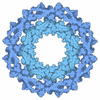
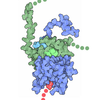


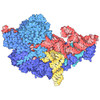



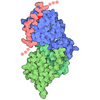
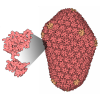



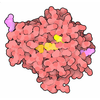
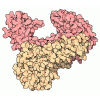
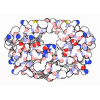

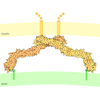

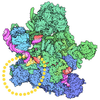
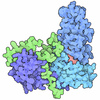


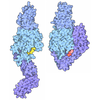




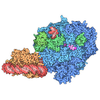
 Z (Sec.)
Z (Sec.) Y (Row.)
Y (Row.) X (Col.)
X (Col.)






















